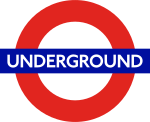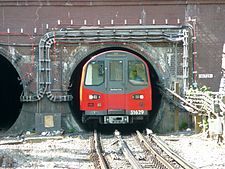| London Underground | |
|---|---|
 | |
 The nickname "Tube" comes from the circular tube-like tunnels through which the small profile trains travel. (Deep-level Northern line London Underground 1995 Stock train). | |
 | |
| Overview | |
| Locale | Greater London, Buckinghamshire, Essex, Hertfordshire |
| Transit type | Rapid transit |
| Number of lines | 11[1] |
| Number of stations | 272 served[1] (262 owned) |
| Daily ridership | 3.23 million (Average for 2023/24)[2] |
| Annual ridership | 1.181 billion (2023/2024)[2] |
| Website | tfl |
| Operation | |
| Began operation | 10 January 1863 |
| Operator(s) | London Underground Limited |
| Reporting marks | LT (National Rail)[3] |
| Technical | |
| System length | 402 km (250 mi)[1] |
| Track gauge |
|
| Electrification | Fourth rail, 630 or 750VDC |
| Average speed | 33 km/h (21 mph)[4] |
| Part of a series on the |
| London Underground |
|---|
 |
|
|
The London Underground (also known simply as the Underground or by its nickname the Tube) is a rapid transit system serving Greater London and some parts of the adjacent home counties of Buckinghamshire, Essex and Hertfordshire in England.[5]

The Underground has its origins in the Metropolitan Railway, opening on 10 January 1863 as the world's first underground passenger railway.[6] The Metropolitan is now part of the Circle, District, Hammersmith & City and Metropolitan lines. The first line to operate underground electric traction trains, the City & South London Railway in 1890, is now part of the Northern line.[7]
The network has expanded to 11 lines with 250 miles (400 km) of track.[8] However, the Underground does not cover most southern parts of Greater London; there are only 33 Underground stations south of the River Thames.[9] The system's 272 stations collectively accommodate up to 5million passenger journeys a day.[10] In 2023/24 it was used for 1.181billion passenger journeys.
The system's first tunnels were built just below the ground, using the cut-and-cover method; later, smaller, roughly circular tunnels—which gave rise to its nickname, the Tube—were dug through at a deeper level.[11] Despite its name, only 45% of the system is under the ground: much of the network in the outer environs of London is on the surface.[8]
The early tube lines, originally owned by several private companies, were brought together under the Underground brand in the early 20th century, and eventually merged along with the sub-surface lines and bus services in 1933 to form London Transport under the control of the London Passenger Transport Board (LPTB). The current operator, London Underground Limited (LUL), is a wholly owned subsidiary of Transport for London (TfL), the statutory corporation responsible for the transport network in London.[11] As of 2015[update], 92% of operational expenditure is covered by passenger fares.[12] The Travelcard ticket was introduced in 1983 and Oyster card, a contactless ticketing system, in 2003.[13] Contactless bank card payments were introduced in 2014,[14] the first such use on a public transport system.[15]
The LPTB commissioned many new station buildings, posters and public artworks in a modernist style.[16][17][18] The schematic Tube map, designed by Harry Beck in 1931, was voted a national design icon in 2006 and now includes other transport systems besides the Underground, such as the Docklands Light Railway, London Overground, Thameslink, the Elizabeth line, and Tramlink. Other famous London Underground branding includes the roundel and the Johnston typeface, created by Edward Johnston in 1916.
- ^ a b c Cite error: The named reference
Key Factswas invoked but never defined (see the help page). - ^ a b Transport for London (4 February 2023). "Public Transport Journeys by Type of Transport". London Datastore. Archived from the original on 22 March 2023. Retrieved 22 March 2023.
- ^ "National Rail Enquiries – London Underground". www.nationalrail.co.uk. Archived from the original on 10 May 2021. Retrieved 21 April 2021.
- ^ Transport for London (29 July 2019). "Facts & figures". Archived from the original on 27 September 2014. Retrieved 18 June 2014.
- ^ "An overview of the British rail industry" (PDF). Office of Rail and Road. 19 December 2014. Archived (PDF) from the original on 3 April 2016. Retrieved 5 January 2017.
- ^ Lee, Charles E (1973). The Metropolitan Line. London: London Transport. p. 7. ISBN 0-85329 033 4.
- ^ Wolmar (2004), p. 135.
- ^ a b Attwooll, Jolyon (5 August 2015). "London Underground: 150 fascinating Tube facts". The Daily Telegraph. London. Archived from the original on 11 January 2022.
- ^ May, Jack (31 March 2017). "Why are there so few tube lines in South London?". City Monitor. Archived from the original on 10 May 2021. Retrieved 10 October 2019.
- ^ "Daily Ridership". Transport for London. Archived from the original on 24 January 2017. Retrieved 22 July 2016.
- ^ a b Croome & Jackson (1993), Preface.
- ^ "Annual Report and Statement of Accounts 2011/12" (PDF). Transport for London. pp. 98, 100. Archived (PDF) from the original on 20 December 2015. Retrieved 25 October 2015.
Fares revenue on LU was £2,410m... Operating expenditure on the Underground increased to £2,630m
- ^ "Annual Report and Statement of Accounts 2011/12" (PDF). TfL. p. 11. Archived (PDF) from the original on 20 December 2015. Retrieved 25 October 2015.
- ^ "Contactless payment on London Underground" (Press release). Transport for London. 9 September 2014. Archived from the original on 10 May 2021. Retrieved 20 November 2017.
- ^ "Licencing London's contactless ticketing system" (Press release). Transport for London. 13 July 2016. Archived from the original on 1 December 2017. Retrieved 20 November 2017.
- ^ "Design in Relation to the Problem: The London Underground". Commercial Art & Industry: 38–59. 1932. Archived from the original on 15 May 2021. Retrieved 21 November 2017.
- ^ Sagittarius (1928). "Celebrities of Advertising II: Frank Pick". Commercial Art & Industry: 168–9. Archived from the original on 1 December 2017. Retrieved 21 November 2017.
- ^ Barman, Christian (1948). "Frank Pick and his Influence on Design in England". Graphis: 70–73. Archived from the original on 15 May 2021. Retrieved 21 November 2017.